(CreateSpace Independent Publishing Platform, 2016)
In 1952 an event happens.
An event that will separate the story in time by decades. Suddenly that event—a birth—is poised to destroy
a well-respected physician’s life.
Following two professionals of different generations, joined together by medicine, this medical malpractice novel is a joint project of Kraft and Robert S. Goodman, M.D.
The story is character driven by two men destined to become adversaries. Is
one player, who believes he has suffered harm by malpractice, the victim
or is the accused the victim? What actually happened and what didn’t?
Is one a villain due to his actions? Or is the other driven by greed,
and as such bent upon destroying a man’s life for personal
gain, the villain?
WARNING: Sexual situations and extreme violence.
Yes, the approach to creating this book page is different from the previous pages.
A piece of The Discovery’s plot
In the past I have led with the dust jacket copy.
I’m not doing it here. What follows isn’t off the book cover.
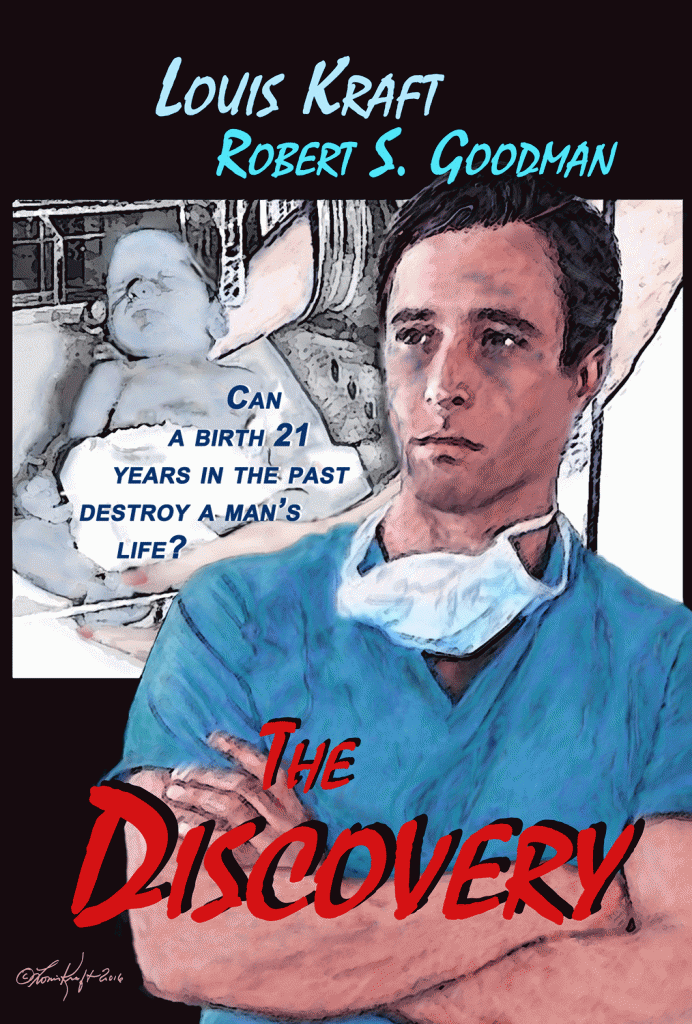
This is a portion of the cover art that I delivered to the publisher (the entire cover was one piece of art, photos, and text) with one difference and that was I removed my signature from the front cover as I didn’t think that it belonged on the book. I’ll deal with the creation of the book cover below. (book cover art © Louis Kraft 2016)
In 1952 Greg Weston was born with a disability. Twenty years later he worked for a major law firm in Los Angeles. His new girlfriend, Gail, raised a question. Mainly, “Were you born this way or could it have been malpractice?” Greg had never given his situation a thought; this was his life and it had always been his life. He not only functioned, he survived quite well in his world.
Still, Gail’s question would not go away, and it would change Greg’s world. His employment offered the perfect place to explore his past and decide what he should do.
Twenty years in the past (1952) Dr. Harry Chapman had delivered Greg Weston. By 1972 Harry Chapman was not only a respected but an honored member of the Westside Hospital in Los Angeles. His private practice thrived. There had been no black marks against his professional career, not one accusation, and no malpractice suits filed against him. By 1972 he had two sons, both of whom had early success in business and raised families. He had an adoring wife, Helen, and his life had nothing but upside.
But then Harry’s life came tumbling toward earth. He had been served with papers that accused him of performing malpractice at Greg Weston’s birth. Although he had $50,000.00 of insurance in 1952, a loophole in the malpractice law limited law suits to one year after the discovery of the incident opened the door for a civil suit to be filed decades after the birth. Worse, as the case was filed in 1972, the insurance company of record in 1952 no longer was involved. His 1972 insurance carrier insured Harry for $2,000,000.00. But since the statute of limitations had long exited the situation, the accusing law firm filed for $4,500,000.00 in damages and $5,000,000.00 for pain and suffering.
If Harry lost in court, he had no profession, no possessions, and no life.
The beginning of a partnership
In early 2010 before I contracted to write for Yahoo! I marked up Dr. Robert S. Goodman’s attempt to write a novel, supplied him copies of the marked up pages along with numerous and extremely detailed documents on what he needed to do to complete his manuscript. …

LK (left) with a former writing coworker at the totally dysfunctional and long gone but not dearly departed Sun Microsystems. Yes, although here he is a brilliant cutout that two or three of the writers in the Monrovia, Calif., writing department created, he was real. (photo © Louis Kraft 2008)
The assignment, which a year or so later eventually included editing memoir-type material, ended. Then in November 2013, at Thanksgiving time, Bob Goodman approached me a second time for more editorial advise on The Discovery, but this time the consulting also included a carrot of a potential writing partnership. My initial intent was to just again be a consultant. But then I learned of a surgery after the fact, a surgery that I was now required to pay for half of it. I had stopped writing for software companies in April 2012 and at that time had decided to never write for the technical world again (The stories I could tell from the 21 or so years would knock you to the floor—either with a knockout punch or hilarity so extreme that you’d be rolled up in a ball and rocking on the floor as you tried to regain control of your emotions). … Trust me, money was tight and I needed to pay for that operation (actually the second that I had not known about until after the fact).
Bob Goodman is a damned fine internal medicine and heart
specialist, a wonderful person, and one of the main reasons I’m still
walking this earth. Back in 2002 my cancer readings became erratic
and slowly climbed and he suggested that I see Dr. Malcolm
Cosgrove, a brilliant doctor and surgeon. If a surgery had
not been performed by Dr. Cosgrove in May 2003
the chances of LK seeing 2004 wouldn’t
have happened.
I gave Bob Goodman an answer in late 2013 (or at the beginning of 2014). Yes! A resounding yes! Reason: I thought that he had created a great premise for a novel (and I wanted to return to fiction).
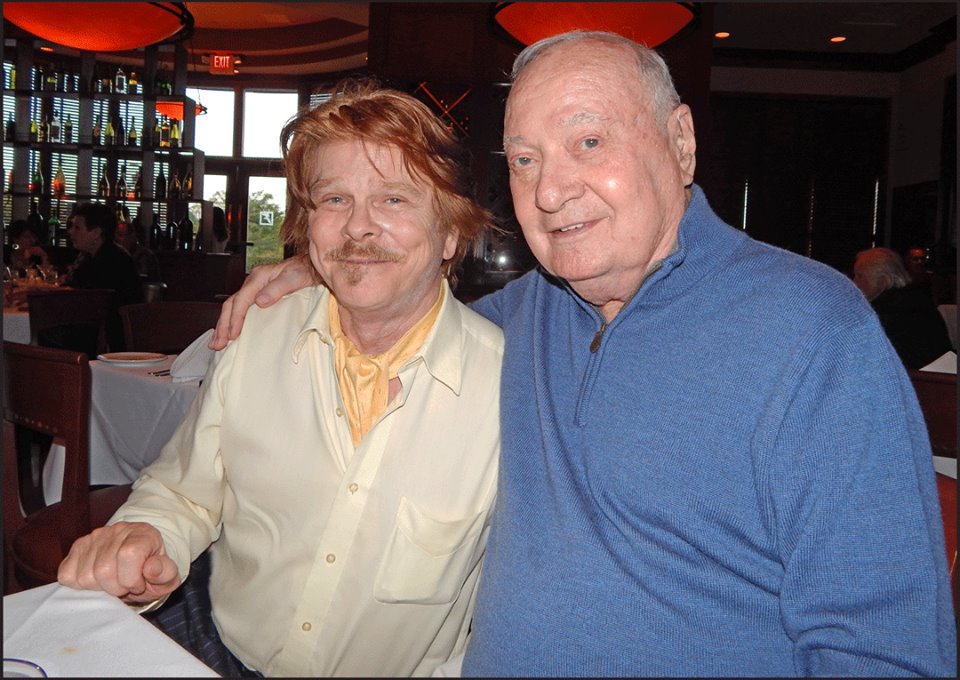
My future wife Pailin Subanna took this photo of me with Bob Goodman at Flemings Steakhouse in Woodland Hills, Calif., on 26jan2014. (photo © Pailin Subanna & Louis Kraft 2014)
I asked Bob if he had incorporated everything in the marked-upped pages including all of my suggestions in the reports and he told me “yes.” I had just signed a three-year contract for an Indian wars book with an advance, and I didn’t think that The Discovery would impact my life much as I wrote almost every day, and including research put in between 9 and 10 hours per day. Bob had said that he followed my suggestions and instructions. How could I lose?
At that point I made one mistake, and that was I believed him. I should have requested another draft before agreeing to become his partner. I didn’t. When I saw his printout of the current draft I was shocked, for not much had changed, … spelling, punctuation, sentence structure, character development, scene development, accurate facts. There were no chapters, and worse many scenes were repeated (even if only a paragraph or two). OUCH!! I had my work cut out for me.
Still Bob Goodman had created a story idea that I really liked.
Go back and look at all that I have written about on my view
that there aren’t many bad people, at least not in their viewpoint,
and the story idea provided a world for me to explore.
A two-year plus project
Develop the characters while steering clear of clichés; at
the same time write the manuscript as a thriller.
For those of you who don’t know how I approach my projects, … I contribute throughout the entire process of creation. This means that I’m not just a writer. I have a view of the final product and I do everything possible to help bring that final vision to delivery. You should know that there are a lot of people in the publishing world (and elsewhere) that don’t like or want my input. They think that I have stepped outside the definition of what a writer is. Maybe they are right, but not in my view. Regardless of what type of writing someone creates—be it fiction, nonfiction, technical, theatrical, whatever—it is art, the art of words. The writer’s words have a vision, just like the so-called vision of a film or theatrical director, and that writer has two choices. 1) Allow others to create his or her vision in a way that isn’t theirs, or 2) To play an active role in the completion of their vision. I choose the second choice, and always have.
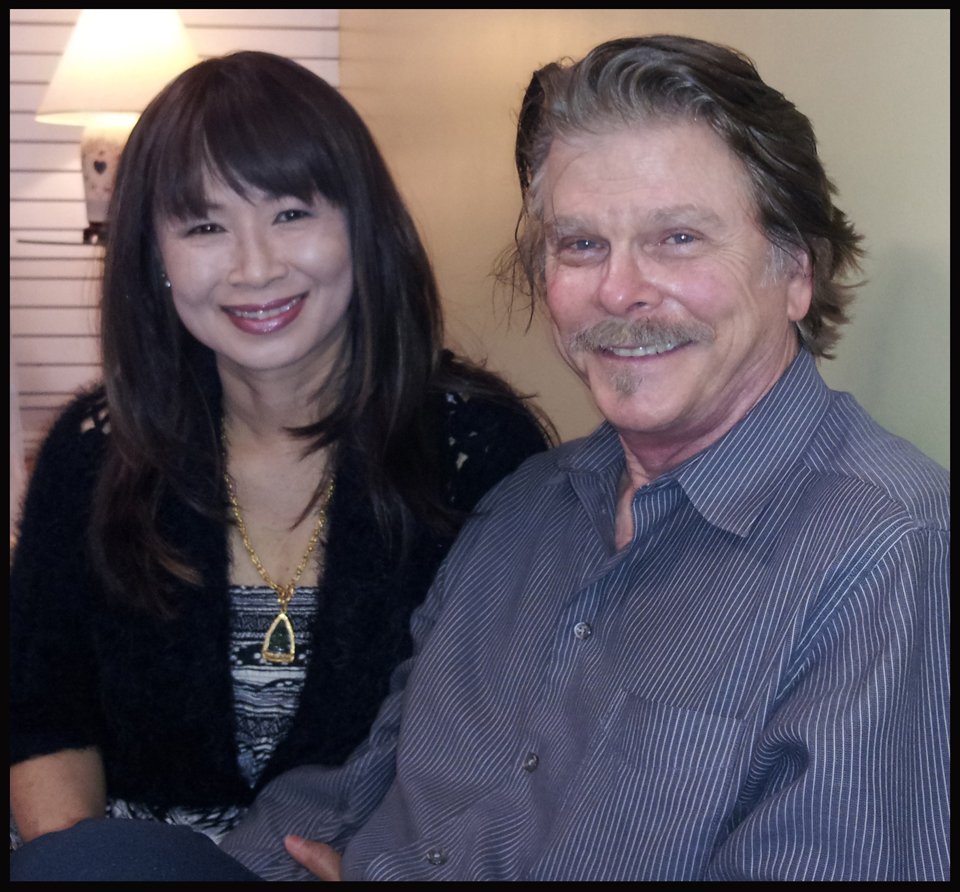
The impact on my life and writing world at the end of 2013 became extreme. I had just signed a contract for a nonfiction book on the Sand Creek Massacre, a lady had entered my life (we would soon marry and begin the process for her Green Card—a process that continues and has swallowed up my days, weeks, months, and much more of my precious time, and this is a continual process with Homeland Security that is still ongoing in 2017). LK with his lady, Pailin Subanna (now Subanna-Kraft). (photo © Pailin Subanna & Louis Kraft 2013)
Although unhappy with the workload in front of me I dove into The Discovery head and soul. At this point in time I never dreamed that it would take me two years to write an acceptable draft that was ready to send out for detailed review copy.
At that point I began to create the images that would be used on the cover and write potential cover text. After I had dealt with the detailed review copy from Vee Morra, Glen Williams, and David DeWitt I created the design for the interior of the book, and only then when I had a final page count did I create the one-piece layout for the book cover.
It took me almost two years to create a draft that I felt might be usable, several months for the review copy and rewrites, and during that time I began working on paintings for the cover art. I had the draft that I sent out for review in late 2015 to Glen, Vee, and David, and for five months I worked nonstop to get The Discovery edited, designed, and published.
The creation of a plot with believable characters
Note that the following won’t expose the plot to you but it will introduce
you to what I faced during the two plus years it took for me to rewrite
a rough and incomplete draft and then do the cover art and
book design. It will also introduce you to most the major
characters and what I used to create them.
Every manuscript has its build-in hurdles that must be conquered. Research, research, and more research and this is true also in fiction. A few examples of what I had to correct from Bob’s original draft or totally understand and create while writing The Discovery included:
- The Ventura 101 Freeway did not exist in 1952
- The Beverly Hills Country Club does not have a golf course
- Other locations in Bob’s draft did not exist in the early 1970s
- I am not a doctor, lawyer, or sailor, and I don’t play golf

LK’s office in Uttaradit, Thailand, on 26nov2014. Pailin and I stayed with her sister and brother-in-law Not and Font Subanna, who are now my brother and sister. I wrote the first rough drafts of five or six chapters there. It was a good time. (photo © Louis Kraft 2014)
This meant that I constantly asked questions, of Bob and of people I knew. Moreover, I constantly had to keep researching all of the above and much more the entire two years that it took me to write the book. … I always believe in many reviews during the entire writing process (my nonfiction manuscripts have at least five knowledgeable reviewers before I deliver the manuscript to the publisher).
For example of why reviews are important: I did not research the vodka that Bob used in his draft, I simply accepted it. This was a major mistake for it didn’t exist at the time of the story, but luckily Bob’s daughter read one of my last drafts before the book went to print and pointed this out. One of my go-to reviewers is a retired registered nurse whose first language is Spanish and she was a godsend in early 2016. Another of my reviewers has reviewed a lot of my work over the years and he always raises good questions and points at plot and dialogue that isn’t working. My third reviewer made it clear that the golfer Phil Rogers would not have reacted positively to Helen Chapman’s sexual advance when she wanted him to do something, and he was dead-on right. I immediately rewrote the scene to show Phil’s horror and disgust.
Channeling LK
In fiction and plays I always channel myself, people I know, and sometimes people I don’t know but have seen perform in film or on stage.
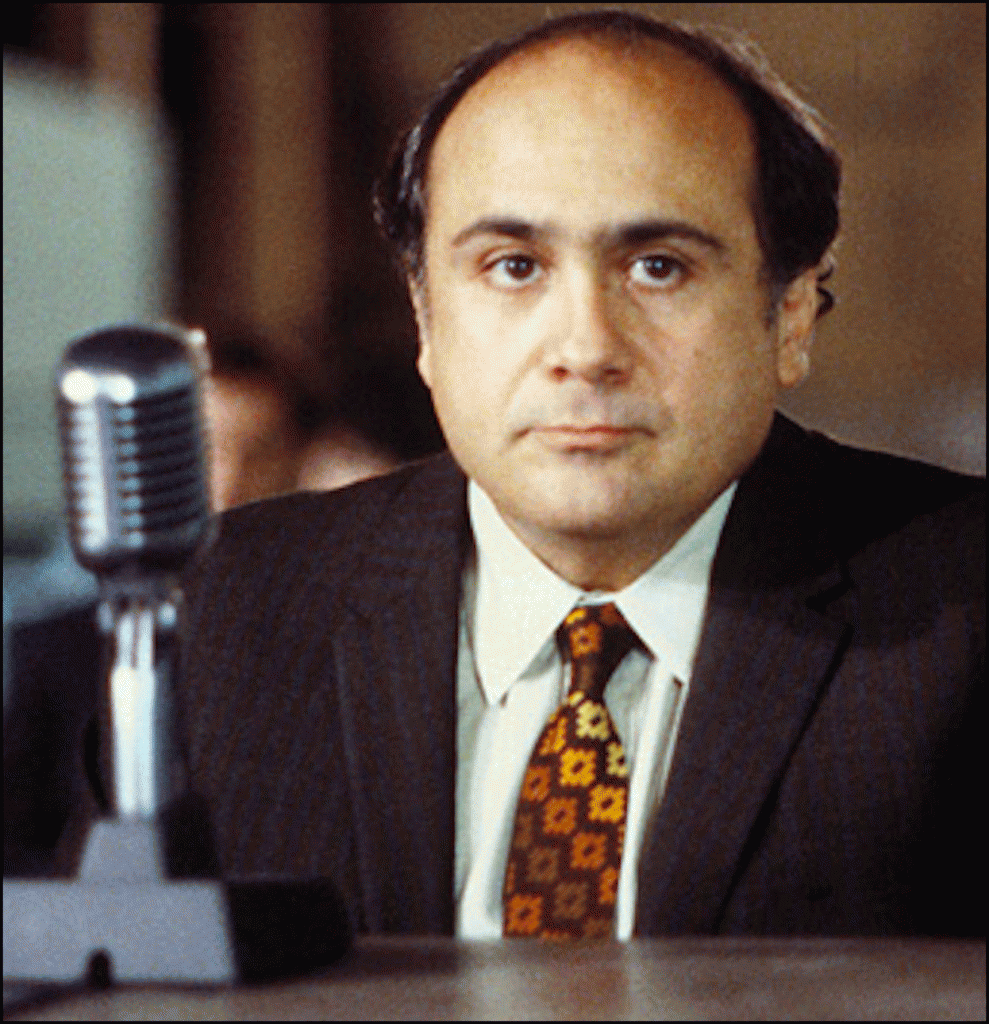
Danny DeVito at the end of Tin Men (1987) when he testified before a committee. He’s somber here but during much of the film he is full of life.
Bob created the lawyer Sid Shapiro as bald, short, and fat (and he eventually became Harry Chapman’s best friend). Sid was the only character that I used a film star as my starting point for character development, and that was Danny DeVito. And when I presented this draft to Bob to review (one of perhaps 10), he told me that he had also envisioned DeVito as Sid. Like they say, sometimes like minds think in like ways. … Sid is smart and successful, but he is also loving and caring. This comes across in DeVito’s acting and I used this to keep Sid totally in focus in every scene that he was in.
I used myself as a starting point for the golfer Phil Rogers and the defense attorney Tom Loman, but I brought them to life in totally different ways. I modeled Rogers after my tastes in culture and décor and physicality, and most of his reactions were true-to-life me if I was placed in his situation. For me what happened to Phil was horrifying (and I don’t ever want that to happen to me). Loman ended up with a lot of good lines, and he is one sharp fellow, but he couldn’t be anything close to Phil so I also used my great friend and director Tom Eubanks, who directed my play Cheyenne Blood and all of my Ned Wynkoop one-man shows in this century.
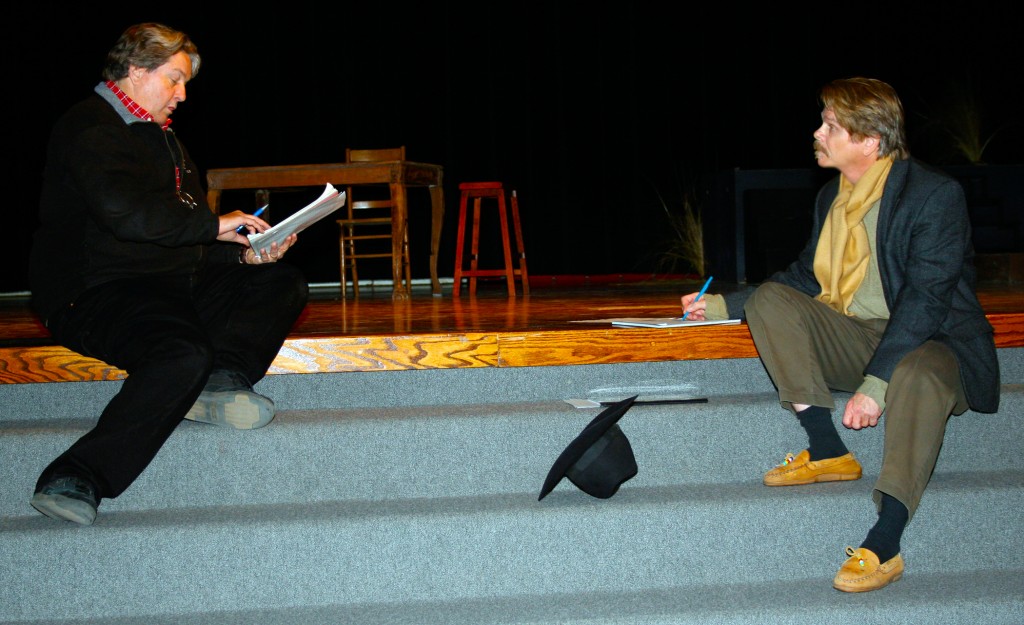
LK receiving notes from director Tom Eubanks after one of the dress rehearsals for Ned Wynkoop: Long Road to Washita in December 2008. The performances were contracted by the Washita Battlefield National Historic Site in Oklahoma. (photo by Johnny D. Boggs 2008)
Tom is hefty and I used his girth for Loman (the hair in the eyes is both Eubanks and myself), and Tom is smart, charming, witty, and for his size exceptionally strong and agile. Tom Loman is my favorite character in the book. My favorite scene in the book is when Judge Kimberly, prosecuting attorney Hal Winslow, and Tom Loman visit a convalescent hospital in Palm Springs to depose a witness who is unable to testify in court. I have been up-front and center with three people that I have loved and watched and held them as they shriveled up to skeletons before dying (a long and slow process). This scene (in chapter 39) tore me up went I wrote it and it still tears me up when I read it. Tom Loman absolutely shines in this scene, making him worth every penny that Harry Chapman paid him.
Two big long shots: The novel is turned into a short television series
(a la Goliath with Billy Bob Thornton who delivered an amazing
performance), and if so both Phil and Tom would be played
by known actors (but it never hurts to dream).
Greg Weston was actually an easy character to develop, mainly because at one time I was a member of the Melrose Theatre in Hollywood during the early 1970s. Here I worked on a number of scenes from Leonard Gershe’s play Butterflies are Free, which opened on Broadway in October 1969 and ran for 1128 performances. The play was about a young blind man who had a relationship with a free-spirited hippie.

LK at the time he spent months studying blindness and rehearsing and performing Butterflies are Free. (photo © Louis Kraft 1973)
I returned to that time and played around with what I had to do then and used it to show that blind people, and Greg in particular, are not helpless human beings. They are alive, and other than not being able to see they learn how to function in their world. Greg is full of life and nothing like the character in the play. He has a good life, and one that he is comfortable living. But when Gail Gordon enters his life, for better or worse, she challenges him and turns his world upside down. Their relationship was probably the easiest one in the book to write. I simply treated them as young lovers tentatively moving forward while not quite able to consummate their love. When she questions his blindness and prompts him to dig into the cause of it she sends the story into overdrive as decisions are made and a nightmare begins. … BTW, the scene in which Greg, along with Gail, meets his birth mother, Laura, is another of my favorite scenes. Here Laura is in complete control while struggling to hide her entire life that had recently ended. I based her on an actress that I knew in mid-1970s.
I do not write villains although some bad things happen in the story. … Even with the gang members I worked as hard as possible to give them dimension and even though they are living outside the law and are deadly I tried to make them as likable as possible.

Back cover for The Discovery. (art and text © Louis Kraft 2016)
Harry and Helen Chapman were based upon few people that I have known over the years including myself. They both descend into the pits of hell as they lose focus of each other and their lives together. They have to be smart, sexy, beautiful, successful, and totally in love. When Greg Weston sues Harry 20 years after his birth the stress should be extraordinary and it must force both of them to spiral out of control. They do hateful things and they hurt people (and in Helen’s case she has committed a major crime), and the trick here is still to retain their humanity for if not there is no story. As the plot moves forward the question for both of them is: Will they survive or will they be totally ruined (with perhaps prison or death). I know what alcoholism is and the portions of the manuscript that deals with drinking were fairly easy to write. It also provided the opportunity to show the strength of Harry’s character when an event happens. It provides hope for his salvation, but which is soon dashed. I know from experience that when someone you love with all your heart suddenly dies it is hard to deal with, for now there are always questions that can no longer be asked or answered.
But then an unexpected event pulls Helen back from all that she had done, and she was as guilty as Harry. Her downward course had been as deadly as Harry’s, but she just hadn’t reached bottom yet. Even though she had cut herself off from Harry, his actions made her realize what she may soon lose. At the same time she was caught in a no-woman’s land of knowing what she had done and what she wants and yet knows what will happen when the truth is known. …
AUTHOR INTERVIEW: Louis Kraft, author of The Discovery
— The Writers Life & Magazine LK interview (June 2017)
Reviews
“The Discovery by co-authors Louis Kraft and Robert S. Goodman is a medical drama wrapped in a legal thriller, which makes for one heck of a fast and compelling read. When we meet the story’s protagonist, Harry Chapman, he’s one of the top OB/GYN practicing in Los Angeles. He has it all: his career, the wife, and the prestige that comes after a long successful practice. All of Harry’s successes makes him the perfect character to lose it all and that’s exactly the premise the novel sets up from the start.
“Jumping back and forth between 1972 and 1952, readers find out that Harry may or may not be responsible for causing blindness in one of the babies he delivered improperly. We are introduced to that baby as an adult who turns out to be Greg Weston, a twenty-year-old blind paralegal who’s advised by a medical professional that he may have a case to sue Harry for medical malpractice. What follows is a case that becomes bigger than either Harry or Greg, as the trial wrecks havoc on their lives as well as the lives of their loved ones; even reaching out to the larger Los Angeles community.
“There are a lot of moving parts and details which need to come out in the narrative, whereas less skilled writers would not have been able to handle. But in the hands of Kraft and Goodman, the book not only flows but also allows readers to fully become immersed in the world of the story and invest emotionally in the outcome of the trial. Since the story is so dependent upon the relationships in the novel, it’s nice to see they don’t get lost in the details of the plot, as is the case with most other books within this genre.
“Ultimately, The Discovery strikes the perfect balance between plot and characterization, which makes it a hard book to put down. Full of complex characters, love, sex and violence this novel is perfect for readers who are fans of medical or legal dramas, as well as those who want to read about complex, colorful and professional characters and unique relationships.
“I compliment the co-authors for working so well together, the book reads as if written by one person. I feel this novel can be adapted into a screenplay and become a movie or TV special, as dealing with blindness in the 1950’s was a common risk for premature babies. Having the doctor face ramifications of such a mishap 20 years later underlies a real situation many can relate to. The storyline credibility and use of vernacular were excellent, total engaging me as a reader.”
— Tiffany Ezuma, Pacific Book Review (March 2017)
“This book is a very different genre for author Louis Kraft. … I have read some of his extremely well-researched historical books on [N]ative Americans, following his career from early on.
“Authors Louis Kraft and Robert S. Goodman have created an intelligent and compelling novel that easily held my attention. This is a complex, carefully constructed drama that touches upon numerous themes while offering a suspenseful and fascinating tale. Writing with knowledge and authority, Kraft and Goodman present a stage populated by diverse characters, each fascinating in their own way, and the suspense builds with each section. At its heart is Harry Chapman, an OB/GYN physician on the verge of retirement who is suddenly hit by a malpractice claim 21 years after the fact. Kraft and Goodman establish the framework immediately. A wave of blindness in premature infants since the 1940s is linked to excessive oxygen in the incubators for preemies. This disorder is called “retrolental fibroplasia,” an actual condition that once plagued preemies. With the historical background explained, The Discovery delves into the many players who will have an effect on Harry Chapman’s life. The drama includes the legal proceedings and fact that a malpractice suit could be filed only because the medical records had been altered, thus negating the time limit for filing. … The novel jumps from the early 1950s to the early 1970s where a grown Greg Weston begins his journey in unraveling his past and initiating legal proceedings against Dr. Harry Chapman. I found myself enthralled by the characters, sympathetic to some, angry at others, and spellbound by the drama as it played out. There are many surprises with these characters, but read the book to see for yourself. This is an excellent novel, and when I was finished with it I was struck by the fact that The Discovery would make a great film. The plot twists in the latter half are superbly handled. The lives of Greg Weston and Harry Chapman are intricately entwined, and their story is impossible to ignore. Highly recommended!”
— Thomas McNulty, author of Errol Flynn: the Life and Career (McFarland, 2004)
Read the entire review on McNulty’s Dispatches from the Last Outlaw blog
“The Discovery is an engrossing novel that takes surprising turns and engages the reader very quickly. Having been a Labor and Delivery nurse in the ’70s, the topic of medical malpractice involving an OB-GYN physician, had special appeal for me. Medicine, love, sex, betrayal, Los Angeles and its gangs and murder, this novel has the reader wanting to know what the outcome will be when everything is said and done. Kudos to L.K. for excellent writing and to Dr. Goodman for the idea.”
— Veronica B. Morra, Amazon (April 21, 2016)
“Harry Chapman, a physician beginning his career, delivered a young indigent woman’s child in 1952. Facts about that birth remained dormant for 20 years. But then, in 1972, an unexpected encounter set in motion a number of events that would impact Chapman’s life, and in ways he never imagined possible. By now, Harry is a successful and honored physician, and perhaps the top OB/GYN practitioner in Los Angeles. Although unknown to him, his world would begin to fall apart when Greg Weston, a young man he doesn’t know, is persuaded by girlfriend Gail Gordon to explore his past-that is, being blind at birth. Greg works for a law firm and knows how to obtain documents. What he discovers infuriates him and he presses forward and presents what he has found to his boss, Hal Winslow, a top malpractice lawyer. Winslow agrees that they have a case, and this initiates a domino effect that will affect a number of lives. Most notably Harry Chapman but also his wife Helen and their family; Harry’s best friend and lawyer, Sid Shapiro; golf pro Phil Rogers; Greg’s birth mother Laura Smith; and even Greg and Gail. … As the case moves toward trial in Los Angeles Superior Court Chapman is shocked by the accusations and what he learns. Bad turns to worse, and Harry secures the services of top malpractice defense attorney Tom Loman, but this is just the beginning of what happened in 1952 for now millions of dollars are at stake. … Add los Niños, the most feared Latino street gang in Los Angeles, to the mix, and suddenly life includes a price tag. As the situation spirals out of control lives begin to fall apart; sex and even the consideration of murder enters the picture. Everything comes down to Harry Chapman vs. Greg Weston with Judge Jason Kimberly presiding, and only one of them will emerge the victor.
— goodreads review (August 2016)
“In addition the hospital records document that the doctor had been drinking on the night of the birth and had alcohol on his breath.”
“Harry Chapman is a young obstetrician whose career is on the rise after just a few short years. Talented at his job and willing to donate his time to teaching hospitals, his track record is spotless until the night when Laura Smith goes into labor. She gives birth to a premature baby she intends to put up for adoption, but the newborn is not breathing when he is delivered. Dr. Chapman orders that the baby be put in an incubator; but when it doesn’t seem to help, he orders maximum oxygen, which has recently been discovered to cause blindness in children. The nurses comply against their better judgment, and, surely enough, the baby goes blind. Now an adult and a paralegal, Greg Weston learns that malpractice is the reason for his blindness, and he intends to sue.
“This story begins in the 1950s and carries on into the 70s, setting up the conflict and the characters in the first two acts before delving into the centerpiece court scenes. The primary themes deal with the way that even actions and decisions made with the best of intentions can have serious, long-term consequences to them–from Dr. Chapman’s attempts to save a child’s life, to his nurse’s tampering with records in an effort to spare Chapman from the very thing that threatens to swallow him two decades later. With the kind of constant legal intensity readers expect from an author like John Grisham, along with the real-world medical expertise brought to the story by one of the two authors, the suspense of seeing everything unfold should keep readers captivated and always ready for another chapter.”
— Michael Radon, The US Review of Books (2017)
Comments
— The Discovery received a Pacific Book Review Star, which is awarded to books of excellent merit.
| Louis Kraft writer © Louis Kraft 2013–2024 |
